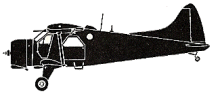
ASN Wikibase Occurrence # 268838
This information is added by users of ASN. Neither ASN nor the Flight Safety Foundation are responsible for the completeness or correctness of this information.
If you feel this information is incomplete or incorrect, you can submit corrected information.
| Date: | Friday 22 December 2000 |
| Time: | 10:45 LT |
| Type: |  de Havilland Canada DHC-2 Beaver |
| Owner/operator: | |
| Registration: | N2502 |
| MSN: | 522 |
| Year of manufacture: | 1952 |
| Total airframe hrs: | 10166 hours |
| Engine model: | P&W R-985 |
| Fatalities: | Fatalities: 0 / Occupants: 2 |
| Aircraft damage: | Substantial |
| Category: | Accident |
| Location: | Kirkland, Washington -
 United States of America United States of America
|
| Phase: | Unknown |
| Nature: | Ferry/positioning |
| Departure airport: | Everett, WA (PAE) |
| Renton, WA (RNT) | |
| Investigating agency: | NTSB |
| Confidence Rating: |
The pilot reported that while in cruise flight at 1,800 feet, operating on the approximately 1/3 full center tank (note: the front tank was full and the rear tank was nearly empty), the aircraft's engine shut down. The pilot switched to the front tank and after about 10 to 15 seconds, the engine restarted. The engine ran smoothly for 15 to 20 seconds, then shut down again, with the fuel pressure reading zero. The pilot attempted to use the hand-operated wobble pump to restore fuel pressure, but was not successful. The pilot then performed a forced landing on what appeared to him to be the only suitable landing area, a high school football/baseball field. The pilot stated that he skidded across the wet field and hit a 10- to 12-foot-high chain link fence straight on at about 30 to 35 MPH. An FAA inspector reported that in a post-accident examination, anomalies with the fuel selector valve's operation were noted, namely, that "The selector valve was found to be able to aspirate to an empty tank in two different ways." The first condition was that "Using the wobble pump to create a suction in the supply-side line, slight inward pressure on the center of the valve would unseat the valve and the prime would be instantly lost. It would be impossible to recover unless the valve was allowed to resume its' [sic] original position." Second, the inspector reported that "With this particular valve it was possible to create enough suction in the selected off position, or in between position, to unseat the valve and cause aspiration to occur." The inspector stated that the condition was repeatable (to a lesser degree) with a newly overhauled valve.
Probable Cause: A malfunction of the aircraft's fuel selector valve and subsequent fuel starvation. Factors included a short emergency landing area, a wet landing surface, and a fence.
Accident investigation:
 |
|
Sources:
NTSB SEA01LA031
Revision history:
| Date/time | Contributor | Updates |
|---|---|---|
| 15-Oct-2021 12:32 | ASN Update Bot | Added |
Corrections or additions? ... Edit this accident description
The Aviation Safety Network is an exclusive service provided by:


 ©2024 Flight Safety Foundation
©2024 Flight Safety Foundation